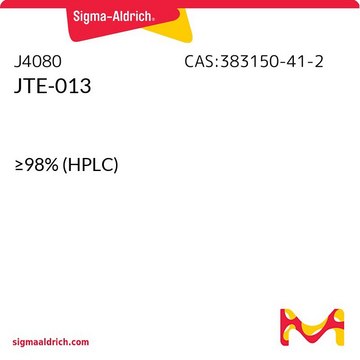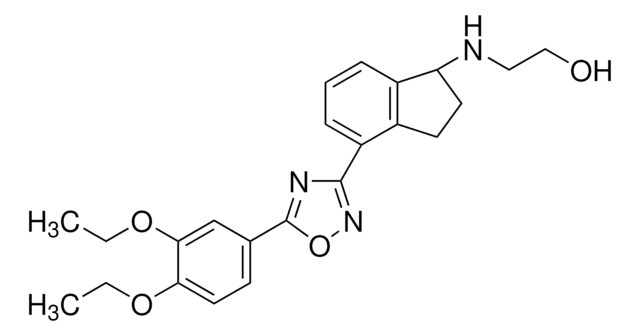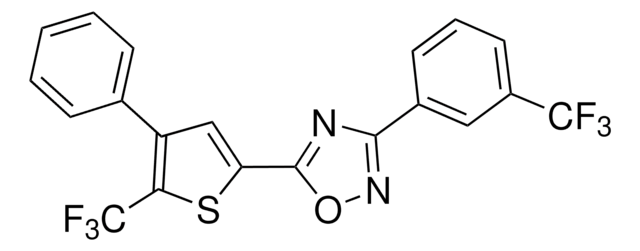SML2099
NIBR-0213
≥98% (HPLC)
别名:
(S)-2-({3′-[(R)-1-(4-Chloro-3-methyl-phenyl)-ethylamino]-3,5-dimethyl-biphenyl-4-carbonyl}-amino)-propionic acid, N-[[3′-[[(1R)-1-(4-Chloro-3-methylphenyl)ethyl]amino]-3,5-dimethyl[1,1′-biphenyl]-4-yl]carbonyl]-L-alanine, NIBR 0213, NIBR0213
登录查看公司和协议定价
所有图片(1)
About This Item
推荐产品
化驗
≥98% (HPLC)
形狀
powder
顏色
white to beige
溶解度
DMSO: 2 mg/mL, clear
儲存溫度
−20°C
SMILES 字串
C[C@@H](C(O)=O)NC(C1=C(C)C=C(C2=CC=CC(N[C@@H](C3=CC=C(Cl)C(C)=C3)C)=C2)C=C1C)=O
InChI
1S/C27H29ClN2O3/c1-15-11-20(9-10-24(15)28)18(4)29-23-8-6-7-21(14-23)22-12-16(2)25(17(3)13-22)26(31)30-19(5)27(32)33/h6-14,18-19,29H,1-5H3,(H,30,31)(H,32,33)/t18-,19+/m1/s1
InChI 密鑰
KYHUARFFBDLROH-MOPGFXCFSA-N
應用
NIBR-0213 may be used as a selective sphingosine-1-phosphate receptor 1 (S1P1) antagonist to assess S1P-mediated nuclear factor kappa B (NF-κB)-p65 nuclear translocation in human induced astrocytes.
生化/生理作用
NIBR-0213 is an orally active, potent and S1P1-selective sphingosine 1-phosphate (S1P) receptor antagonist that blocks S1P1-selective ligand AUY954-induced Ca2+ mobilization (IC50 = 2.5 nM using human S1P1-transfected HeLa cells; IC50 >10 μM with human S1P2, S1P3, or S1P4 transfectants) and S1P-induced GTPγS recruitment (IC50 = 2.0/2.3/8.5 nM using membrane from human/murine/rat S1P1-transfected CHO cells; IC50 >10 μM with membrane from human S1P5 transfectant). NIBR-0213 induces long-lasting peripheral blood lymphocyte reduction in rats (EDmax = 1 mg/kg, ED50 = 0.2 mg/kg; p.o.) and exhibits therapeutic efficacy (30 mg/kg p.o; BID) in experimental autoimmune encephalomyelitis (EAE), a murine model of multiple sclerosis (MS), with no adverse effects to the animals.
Orally active, potent and selective S1P1 antagonist with therapeutic efficacy in a murine model of multiple sclerosis (MS).
儲存類別代碼
11 - Combustible Solids
水污染物質分類(WGK)
WGK 3
閃點(°F)
Not applicable
閃點(°C)
Not applicable
A potent and selective S1P(1) antagonist with efficacy in experimental autoimmune encephalomyelitis.
Jean Quancard et al.
Chemistry & biology, 19(9), 1142-1151 (2012-09-25)
Lymphocyte trafficking is critically regulated by the Sphingosine 1-phosphate receptor-1 (S1P(1)), a G protein-coupled receptor that has been highlighted as a promising therapeutic target in autoimmunity. Fingolimod (FTY720, Gilenya) is a S1P(1) receptor agonist that has recently been approved for
Sofia Anastasiadou et al.
Experimental neurology, 279, 243-260 (2016-03-17)
Fingolimod (FTY720) is a new generation oral treatment for multiple sclerosis (MS). So far, FTY720 was mainly considered to target trafficking of immune cells but not brain cells such as neurons. Herein, we analyzed FTY720's potential to directly alter neuronal
Emanuela Colombo et al.
Frontiers in immunology, 11, 635-635 (2020-04-24)
Multiple sclerosis (MS) is an inflammatory neurodegenerative disease of the central nervous system (CNS) with heterogeneous pathophysiology. In its progressive course oligodendrocyte and neuroaxonal damage is sustained by compartmentalized inflammation due to glial dysregulation. Siponimod (BAF312), a modulator of two
Victoria Fang et al.
Nature immunology, 18(1), 15-25 (2016-11-15)
The lymph node periphery is an important site for many immunological functions, from pathogen containment to the differentiation of helper T cells, yet the cues that position cells in this region are largely undefined. Here, through the use of a
Marc Bigaud et al.
PloS one, 11(12), e0168252-e0168252 (2016-12-23)
Homeostasis of vascular barriers depends upon sphingosine 1-phosphate (S1P) signaling via the S1P1 receptor. Accordingly, S1P1 competitive antagonism is known to reduce vascular barrier integrity with still unclear pathophysiological consequences. This was explored in the present study using NIBR-0213, a
我们的科学家团队拥有各种研究领域经验,包括生命科学、材料科学、化学合成、色谱、分析及许多其他领域.
联系技术服务部门








